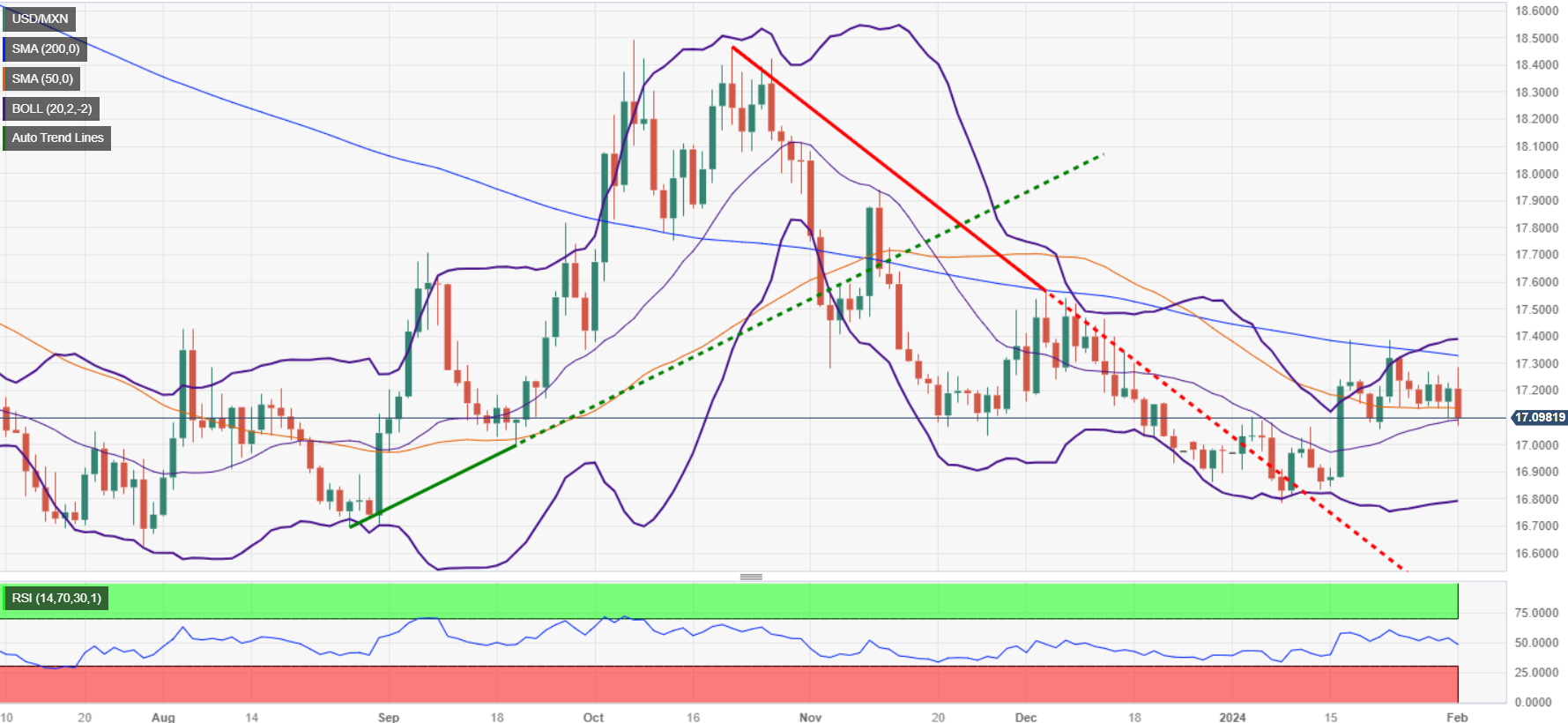Most recent article: Mexican Peso weakens against US Dollar on US NFP data
- Mexican Peso appreciates against the Dollar, driven by the recent Fed decision and softer US employment figures.
- Banxico's survey indicates expectations of a rate cut to 9.25% and a year-end exchange rate forecast of 18.50, influencing market sentiment.
- Mexico's manufacturing sector shows expansion with a slowdown, contrasting with US data that points to a cooling labor market but increasing manufacturing activity.
The Mexican Peso (MXN) climbed against the US Dollar (USD) on Thursday as market participants digested the latest Federal Reserve (Fed) decision. Alongside that, softer employment figures in the United States (US) and a risk-on impulse favor the emerging market currency. The USD/MXN trades at 17.08, down by 0.76%.
The Bank of Mexico (Banxico) revealed its survey of expectations on Thursday, showing that analysts estimate the bank will lower rates to 9.25% and expect the exchange rate to end at 18.50. In regard to inflation expectations, private analysts estimate it to hit 4.17% and economic growth to range from 2.29% to 2.40%.
Meanwhile, Mexico’s economic docket featuring that business activity in the manufacturing sector expanded, but it’s slowing down. In the meantime, US economic data showed the labor market is cooling while manufacturing activity gathers steam.
Daily digest market movers: Mexican Peso appreciates as US Dollar weakens on mixed US data
- S&P Global revealed that manufacturing activity in Mexico is slowing sharply, with the PMI dipping from 52.0 in December to 50.2.
- US Initial Jobless Claims for the last week rose 224K, exceeding the previous reading of 215K and forecasts of 215K. The data suggests the labor market is cooling amid a period in which US companies announced plans to cut over 82,300 jobs in the last month.
- The S&P Global Manufacturing PMI improved from 47.9 to 50.7 in January. The Institute for Supply Management’s (ISM) Manufacturing PMI improved from 47.1 to 49.1, exceeding forecasts of 47.
- USD/MXN traders continued to digest the latest Federal Reserve decision to hold rates unchanged as widely expected and adopted a neutral stance. Even though officials had opened the door to cut interest rates, they emphasized the need for reassurance that inflation is “sustainably” moving toward its 2% goal. Regarding the balance sheet, its reduction would continue as outlined in May of 2023.
- Mexico’s economy grew below forecasts in the last quarter of 2023. GDP expanded 0.1% QoQ, trailing Q3 1.1% growth and forecasts of 0.4%.
- Given that the Mexican economy remains solid, according to the data revealed in January, the Bank of Mexico (Banxico) could delay easing monetary policy as conditions remain hotter than expected.
- However, if Banxico’s officials remain determined to begin its easing cycle in Q1 of 2024, that could depreciate the emerging market currency due to the reduction of interest rate differentials. That could also underpin the USD/MXN pair on its way toward the psychological 18.00 figure.
- Additional factors that might depreciate the Mexican currency are geopolitical risks and risk aversion.
Technical Analysis: Mexican Peso stages a comeback as USD/MXN breaks below 17.15
The USD/MXN remains trading sideways, but it has pierced below the 50-day Simple Moving Average (SMA) at 17.13, exposing the exotic pair to further losses. If sellers reclaim the January 22 daily low of 17.05, that could open the door to challenging the 17.00 figure.
On the flip side, if buyers reclaim the 50-day SMA at 17.13, that could exacerbate a rally to 17.20. Once that level is cleared, the next resistance would be the 200-day SMA at 17.33, followed by the 100-day SMA at 17.38.
USD/MXN Price Action – Daily Chart
Mexican Peso FAQs
What key factors drive the Mexican Peso?
The Mexican Peso (MXN) is the most traded currency among its Latin American peers. Its value is broadly determined by the performance of the Mexican economy, the country’s central bank’s policy, the amount of foreign investment in the country and even the levels of remittances sent by Mexicans who live abroad, particularly in the United States. Geopolitical trends can also move MXN: for example, the process of nearshoring – or the decision by some firms to relocate manufacturing capacity and supply chains closer to their home countries – is also seen as a catalyst for the Mexican currency as the country is considered a key manufacturing hub in the American continent. Another catalyst for MXN is Oil prices as Mexico is a key exporter of the commodity.
How do decisions of the Banxico impact the Mexican Peso?
The main objective of Mexico’s central bank, also known as Banxico, is to maintain inflation at low and stable levels (at or close to its target of 3%, the midpoint in a tolerance band of between 2% and 4%). To this end, the bank sets an appropriate level of interest rates. When inflation is too high, Banxico will attempt to tame it by raising interest rates, making it more expensive for households and businesses to borrow money, thus cooling demand and the overall economy. Higher interest rates are generally positive for the Mexican Peso (MXN) as they lead to higher yields, making the country a more attractive place for investors. On the contrary, lower interest rates tend to weaken MXN.
How does economic data influence the value of the Mexican Peso?
Macroeconomic data releases are key to assess the state of the economy and can have an impact on the Mexican Peso (MXN) valuation. A strong Mexican economy, based on high economic growth, low unemployment and high confidence is good for MXN. Not only does it attract more foreign investment but it may encourage the Bank of Mexico (Banxico) to increase interest rates, particularly if this strength comes together with elevated inflation. However, if economic data is weak, MXN is likely to depreciate.
How does broader risk sentiment impact the Mexican Peso?
As an emerging-market currency, the Mexican Peso (MXN) tends to strive during risk-on periods, or when investors perceive that broader market risks are low and thus are eager to engage with investments that carry a higher risk. Conversely, MXN tends to weaken at times of market turbulence or economic uncertainty as investors tend to sell higher-risk assets and flee to the more-stable safe havens.
Information on these pages contains forward-looking statements that involve risks and uncertainties. Markets and instruments profiled on this page are for informational purposes only and should not in any way come across as a recommendation to buy or sell in these assets. You should do your own thorough research before making any investment decisions. FXStreet does not in any way guarantee that this information is free from mistakes, errors, or material misstatements. It also does not guarantee that this information is of a timely nature. Investing in Open Markets involves a great deal of risk, including the loss of all or a portion of your investment, as well as emotional distress. All risks, losses and costs associated with investing, including total loss of principal, are your responsibility. The views and opinions expressed in this article are those of the authors and do not necessarily reflect the official policy or position of FXStreet nor its advertisers. The author will not be held responsible for information that is found at the end of links posted on this page.
If not otherwise explicitly mentioned in the body of the article, at the time of writing, the author has no position in any stock mentioned in this article and no business relationship with any company mentioned. The author has not received compensation for writing this article, other than from FXStreet.
FXStreet and the author do not provide personalized recommendations. The author makes no representations as to the accuracy, completeness, or suitability of this information. FXStreet and the author will not be liable for any errors, omissions or any losses, injuries or damages arising from this information and its display or use. Errors and omissions excepted.
The author and FXStreet are not registered investment advisors and nothing in this article is intended to be investment advice.
Recommended content
Editors’ Picks

Gold climbs to new all-time high above $3,400
Gold extends its uptrend and trades at a new all-time high above $3,400 on Monday. Concerns over US-China trade war escalation and the Fed’s independence smash the US Dollar to three-year troughs, fuelling XAU/USD's rally.

EUR/USD clings to strong gains above 1.1500 on persistent USD weakness
EUR/USD gains more than 1% on the day and trades at its highest level since November 2021 above 1.1500. The relentless US Dollar selling helps the pair push higher as fears over a US economic recession and the Federal Reserve’s autonomy grow.

GBP/USD tests 1.3400 as USD selloff continues
GBP/USD continues its winning streak, testing 1.3400 on Monday. The extended US Dollar weakness, amid US-Sino trade war-led recession fears and heightened threat to the Fed's independence, underpin the pair following the long weekend.

How to make sense of crypto recovery – Is it a buy or fakeout
Bitcoin (BTC), Ethereum (ETH) and XRP, the top three cryptocurrencies by market capitalization, extend their last week’s recovery on Monday, even as trader sentiment is hurt by the US President Donald Trump’s tariff policy and announcements.

Five fundamentals for the week: Traders confront the trade war, important surveys, key Fed speech Premium
Will the US strike a trade deal with Japan? That would be positive progress. However, recent developments are not that positive, and there's only one certainty: headlines will dominate markets. Fresh US economic data is also of interest.

The Best brokers to trade EUR/USD
SPONSORED Discover the top brokers for trading EUR/USD in 2025. Our list features brokers with competitive spreads, fast execution, and powerful platforms. Whether you're a beginner or an expert, find the right partner to navigate the dynamic Forex market.




